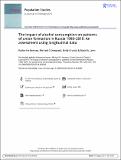The impact of alcohol consumption on patterns of union formation in Russia 1998–2010 : an assessment using longitudinal data
Abstract
Using data from the Russian Longitudinal Monitoring Survey, 1998–2010, we investigated the extent to which patterns of alcohol consumption in Russia are associated with the subsequent likelihood of entry into cohabitation and marriage. Using discrete-time event history analysis we estimated for 16–50 year olds the extent to which the probabilities of entry into the two types of union were affected by the amount of alcohol drunk and the pattern of drinking, adjusted to allow for social and demographic factors including income, employment, and health. The results show that individuals who did not drink alcohol were less likely to embark on either cohabitation or marriage, that frequent consumption of alcohol was associated with a greater chance of entering unmarried cohabitation than of entering into a marriage, and that heavy drinkers were less likely to convert their relationship from cohabitation to marriage.
Citation
Keenan , K , Kenward , M G , Grundy , E & Leon , D A 2014 , ' The impact of alcohol consumption on patterns of union formation in Russia 1998–2010 : an assessment using longitudinal data ' , Population Studies , vol. 68 , no. 3 , pp. 283-303 . https://doi.org/10.1080/00324728.2014.955045
Publication
Population Studies
Status
Peer reviewed
ISSN
0032-4728Type
Journal article
Rights
© 2014 The Author(s). Published by Taylor & Francis. This is an Open Access article distributed under the terms of the Creative Commons Attribution License (http://creativecommons.org/Licenses/by/4.0/), which permits unrestricted use, distribution, and reproduction in any medium, provided the original work is properly cited.
Description
Research for this paper was funded by Economic and Social Research Council grant: ES/I903224/1.Items in the St Andrews Research Repository are protected by copyright, with all rights reserved, unless otherwise indicated.

